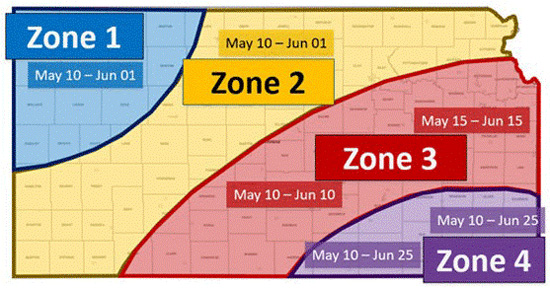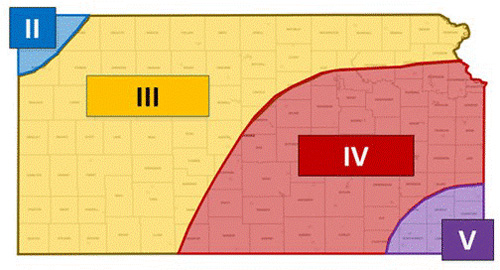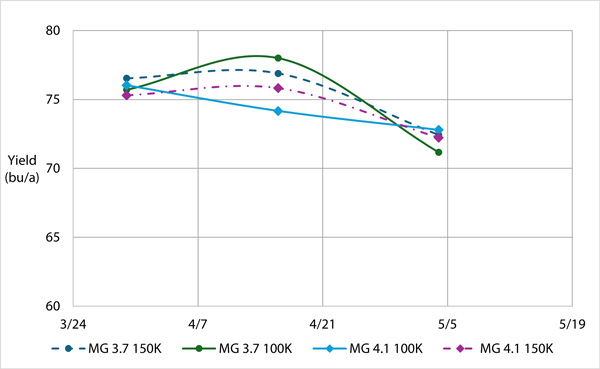For maximizing soybean yield, there are key practices that cannot be overlooked. This article presents tips for selecting the best planting date and maturity group across the different crop regions in Kansas.
After considering the effects of genetic yield potential and the environment, planting date is one of the primary management practices under the farmer’s control that can highly influence soybean yields. In recent years, Kansas producers have been planting soybeans slightly earlier -- at the rate of about one-third-of-day per year. In 2024, the “50% planting date” mark was achieved around May 26 statewide (ahead of the 42% historical average) – with planting progress moving closer to mid-May if conditions are optimal at that time (USDA-Crop Progress Reports).
Planting dates and maturity group guidelines
Soybeans can be planted over a wide range of dates with adequate soil moisture conditions, although germination and emergence could be reduced and/or delayed in cool soils (less than 60°F). In the last few years, many farmers have anticipated soybean planting dates relative to the ones presented in Figure 1, in many situations, planting soybeans before corn. The recommended maturity group varies across Kansas by area (Figure 2).

Figure 1. Recommended soybean planting dates under dryland conditions. K-State Research and Extension.

Figure 2. Recommended soybean maturity groups (II to V) across Kansas. K-State Research and Extension.
Over the four years at the Kansas River Valley Experiment Field, soybean yields were either stable or increased when planting in late March/early April compared to planting in mid-to-late April and early-to-mid May (Figure 3).

Figure 3: The effect of planting date on irrigated soybean yield at the Kansas River Valley Experiment Field in 2021-2024. Each line represents a maturity group (MG 3.7 or MG 4.1) and seeding rate (100K or 150K).
Generalized for Kansas, maximum soybean yield is reduced by 0.3 bu/a per day as planting dates get later in the season, with higher yield when planting in mid-April compared to moderate yields (50 bu/a) when planting in mid-July. These results highlight the importance of early planting for obtaining maximum yields and the yield penalty associated with later planting dates. Earlier planting means more risk (variability in yield) but a potentially higher yield or reward. Later-planted beans tend to be less variable with better yield stability, though maximum yield potential can be lost.
Historically, there has been a trend of planting soybeans early, before corn in some cases. A note of caution is that lower soil temperatures will delay emergence and could compromise stand uniformity. In addition, dry conditions can further delay overall emergence, impacting early season uniformity.
If planting early, try to maximize plant survival and reduce threats to emergence by:
- Avoiding planting when soil temperatures are below 60°F. If planted into soils cooler than 60°F, seedlings may eventually emerge but will have poor vigor.
- Treating seeds with fungicide and insecticide.
- Selecting varieties with resistance to soybean cyst nematode and sudden death syndrome.
Final considerations
- Ultimately, weather patterns dictate soybean yields, especially under dryland conditions. There is no guarantee that any certain planting date will always work out best for soybean yields across Kansas. The distribution and amount of rainfall and the day/night temperature variations around flowering and during the grain-filling periods also greatly impact soybean yields. When the risk of drought stress during the growing season is high, diversifying planting dates may be the best approach.
- When planting early (the push to plant soybeans before corn), seed should be treated with a fungicide and insecticide. Select varieties with resistance to soybean cyst nematode and sudden death syndrome. In general, do not plant in soils that are too wet and until soil temperatures are close to 60°F. If planted into soils cooler than 60°F, seedlings may eventually emerge but will have poor vigor.
- In drier areas and shallow soil, yields have been most consistent when soybeans are planted in late May to early June. By planting during that window, soybeans will bloom and fill seed in August and early September, when nights are cooler, and the worst of heat and drought stress is usually over.
Tina Sullivan, Northeast Area Agronomist
tsullivan@ksu.edu
Logan Simon, Southwest Area Agronomist
lsimon@ksu.edu
Eric Adee, Agronomist
eadee@ksu.edu